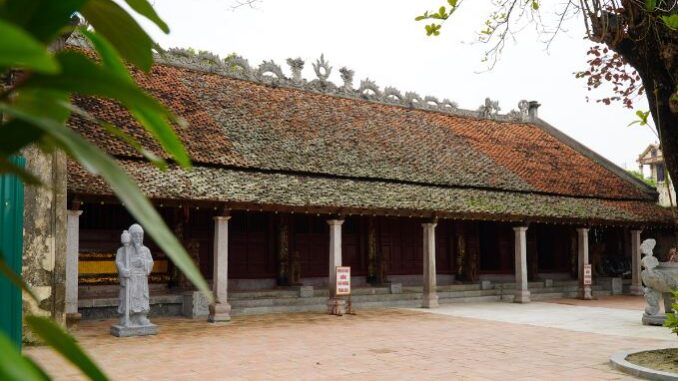
THANH HOA – Thai temple of the Le dynasty, also known as the Le temple in Bo Ve land, built more than 200 years ago, is the most sacred and magnificent temple in Thanh land.

The Thai Temple of the Hau Le Dynasty is located in an area of more than 4,200 m2 in Dong Ve Ward, Thanh Hoa City. The ancient temple consists of consecutive works such as Nghinh Mon, Electric Courtyard, Pre-Electricity, and Post-Electricity.
According to historical books, the Thai Temple of the Later Le Dynasty was originally built in Lam Kinh land (Tho Xuan, Thanh Hoa) under the reign of King Le Thai To and completed during the reign of the successors of Le Thai Tong (1433-1442) and Le Nhan. Tong (1442-1459). After the fire, the Thai Temple was moved to Thang Long with the name Hoang Duc Palace.
In 1805, King Gia Long ordered to move the Thai temple of the Later Le dynasty from Thang Long to Bo Ve land, next to Thanh Hoa citadel, now Quang Xa village, Dong Ve ward.

Nghinh Mon Le temple is located next to a small road in Quang Xa village.

Next to the door is to the screen and then the electric field. In the past, this place had two rows of houses left Vu and Huu Vu (two rows of houses next to each other), each row consisted of 7 compartments but was later demolished. The work is currently being restored and embellished by Thanh Hoa province.

The main architecture of the Thai Mieu consists of two buildings: the front and the back hall, arranged in a row, consisting of 7 compartments, the roof is roofed with tiled nose, the top of the roof is elaborately decorated with the symbol “two dragons adoring the moon” running near. off the roof.

In front of the Tien Dien, there are two 6-meter-high fangs, on each fang column there are two cymbals and below are the presence of 6 wooden cymbals made from jackfruit wood, exquisitely carved. In feudal times, Nghe was a symbol of strength, neutralized murderous intent and brought fortune.

The electric money has 5 altars, in the middle is the altar to worship the council of mandarins, on both sides to worship the kings of the Later Le dynasty.

The remaining two altars on the left side worship the two founding fathers of the country, Nguyen Trai, and the right side worships Le Lai – two martial arts officials who made great contributions to the Lam Son uprising.

The post-electricity is designed in the way of “stacking with traps” with a system of 32 columns (8 columns in horizontal rows and 4 columns in vertical rows), with rocks at the feet. On the body of the pillars are painted red and decorated with dragons in clouds, elaborately carved.

The Hau Palace now worships the tablets of all 27 kings (21 in office and 6 posthumously crowned) of the Later Le Dynasty (1418 – 1789) and the Queen Mothers and four ancient saints (Le Thai To, Le Than Tong, Le Huyen Tong, Le Gia Tong).

The saint of Thai To Cao Emperor and the tablet of Le Than Tong are two of the saints that historians consider rare and unique in Thanh.

In addition to the statue of King Le Thai To (Le Loi), at the Le Thai Temple, there are also 6 statues of Emperor Than Tong and five different stateless women: Holland, Muong, two Cham wives and a Kinh woman. North – these are statues of great historical and sculptural value.

Under the Nguyen Dynasty, the Thai Mieu was considered the national shrine and annually sacrificed in the spring and autumn periods by provincial officials.
Every year, on the 21st and 22nd of the 8th lunar month, the people of Thanh Hoa organize festival activities, offer incense at Lam Kinh, the Thai temple of the Later Le Dynasty and the Le Loi Monument as a unique historical tradition. maintained since ages.
Currently, Thanh Hoa City is restoring and renovating the Thai temple and neighboring historical and cultural sites in order to attract more tourists to visit and develop tourism. Mr. Le Hoang, Head of Ham Rong Historical and Cultural Relic Management Board, said that on average, the Thai temple welcomes over 5,000 tourists every year to visit and pilgrimage, focusing most on the Lunar New Year and Festivals. Lam Kinh.
( According to vnexpress )
